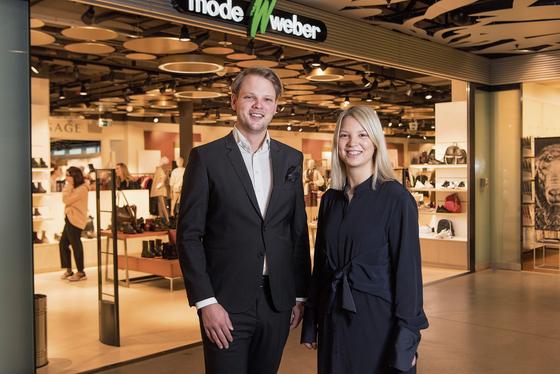SEAK’s workforce management, which is used by retailers to control staff scheduling, is not a cold cost-cutting tool, but a system that also integrates the interests of employees. This holistic approach can be felt and experienced in daily work with the SEAK system – says Lukas Weber, fashion retailer from St. Gallen (Switzerland). The entrepreneur also benefits from additional time resources that the system frees up at management level.
Mode Weber is one of the top fashion retailers in Eastern Switzerland. The family business was founded in 1919 by Ernst and Anna Weber. Today, Weber Apparel AG, based in St. Gallen, owns seven multi-label clothing stores with over 150 brands such as Marc Cain, Drykorn, Moncler or Zegna, ten mono-brand stores (franchises) from Marc Cain, Marc O’Polo and Street One (8 ) as well as a shoe shop. “We are very strongly anchored locally, have a high level of advisory competence and offer international fashion that has been specially interpreted and carefully compiled for Switzerland,” says Lukas Weber, member of the management team.
Communication and the flow of information are now much more efficient. For example, we can see much faster than before whether an employee can be swapped from a particular store. It is also easier to enter and save employee requests with regard to working times and free time.
Overall, the transparency is great. All information can be called up quickly and making calls is usually no longer necessary.
Lukas Weber, member of the Mode Weber management team
Weber employs around 220 people (the equivalent of 150 full-time employees) – too many to schedule staff “by hand” fairly, transparently and at the same time in a frequency-oriented manner. Since the end of 2018, Weber has therefore adopted software from SEAK for the areas of time management, staff scheduling and performance analysis. We asked Lukas Weber a few questions about this.
What challenges did you face at the time when you decided to adopt SEAK software?
Lukas Weber: Up until then we had done the staff scheduling for each store manually and were looking for a solution that would make this work easier for us. But at the same time we are aware that there is a general decline in visitor frequencies in brick-and-mortar retail. Hence we face the additional task of reducing the ratio of staff costs to sales. We were therefore also looking for support in this arena as the software can optimize staff scheduling.
How did you get to know SEAK?
Weber: Through friends from the fashion industry. The management consultants from hachmeister + partner also recommended SEAK to us.

Which processes were changed?
Weber: The process itself is still to have a planner for each store and to carry out the planning process in accordance with the sales plan for each day. But with the SEAK system we can now take almost every detail and relevant aspect into account. It’s very comprehensive.
What’s working out better today than before?
Weber: In the short period of time since the introduction of the SEAK solutions, productivity in staff management and payroll accounting have increased. Relevant information about employees can now be called up in a particularly easy way. In addition, the flow of information at management level has improved significantly.
Who works with IT from SEAK at your company?
Weber: Every multi-label store manager. The same applies to the monobrand stores. But there is also a higher-level HR manager for all stores, who also uses the SEAK solution. There are also the areas of staff management and payroll accounting. We also use SEAK here.
Has your cooperation with the employees who work with SEAK changed? Are there any topics that you have been able to talk about in a more differentiated manner since the introduction of SEAK, or that you are now even addressing for the first time?
Weber: All communication and the flow of information are now much more efficient. For example, we can see much faster than before whether an employee can be swapped from a particular store. It is also easier to enter and save employee requests with regard to working times and free time. Overall, the transparency is great. All information can be called up quickly. Making calls is usually no longer necessary.
How do you measure the success of your investment in SEAK software?
Weber: the investment will be quantitatively assessed against whether it is possible to reduce the staff cost ratio in the medium term. Employee and customer satisfaction will be further aspects to consider. But it is still too early to evaluate. What can already be measured, however, is that the task of staff scheduling has become a lot less time consuming for managers. That has freed up resources at management level.
Are there any reports that you particularly like to check?
Weber: Yes, the evaluations of the performance of the employees and the conversion rate, i.e. the percentage of visitors who buy. I also call up these data from the TPM on my mobile devices. In the future, we want to use this to increasingly compare the services and the individual stores with one another.


Staff scheduling à la SEAK should also change the daily work routine for the employees in a positive way. Do you notice that? Do you have positive feedback from your team?
Weber: Yes. The schedules are just more fair now. The transparency ensures that the employees feel comfortable.
SEAK wants to harmonise the goals of companies and employees with the expectations of customers in regard to service and consultations. Does that reflect your experience working with it? Is it successful?
Weber: You can feel very quickly that as a matter of principle SEAK is never solely concerned with reducing costs. Because when working with the software, the appreciation for the employees in sales becomes noticeable. A very human approach.
How do you rate the SEAK support and hotline?
Weber: So far there has hardly been any reason to use the support.
Were there any surprises in working with the SEAK solutions?
Weber: Yes. We always thought we were good planners. But SEAK has shown that there is room for improvement. We had not expected that. It was also surprising how quickly and easily the software solutions were introduced.
What would you consider as “typically SEAK”? I there such as thing as company DNA in software?
Weber: I find SEAK to be extremely analytical. At the beginning it can be a bit tedious to grasp the SEAK system as a whole, because it is so extensive, because SEAK thinks of every detail. But then you realise that otherwise complex planning tasks actually work comparatively easily with the software. That’s typically SEAK.
Are there any wishes that have remained open?
Weber: No. We now have to find the time internally to exhaust the possibilities of the system and further optimise our staff scheduling.
What other plans do you have? Where do you see a need for action?
Weber: SEAK’s software automatically generates suggestions for staff scheduling. We want to take these into account more than we have before. So far we have held back because we want to introduce changes step by step to ensure that our employees accept them. We will also use the TPM as an analysis tool much more intensively in the future. All of this serves the goal of lowering the staff cost ratio.
We would like to thank Lukas Weber from Mode Weber for the interview. The interview was conducted by retail journalist Bruno Reiferscheid.
Read more success stories here >
Photos © Mode Weber, unless otherwise indicated
